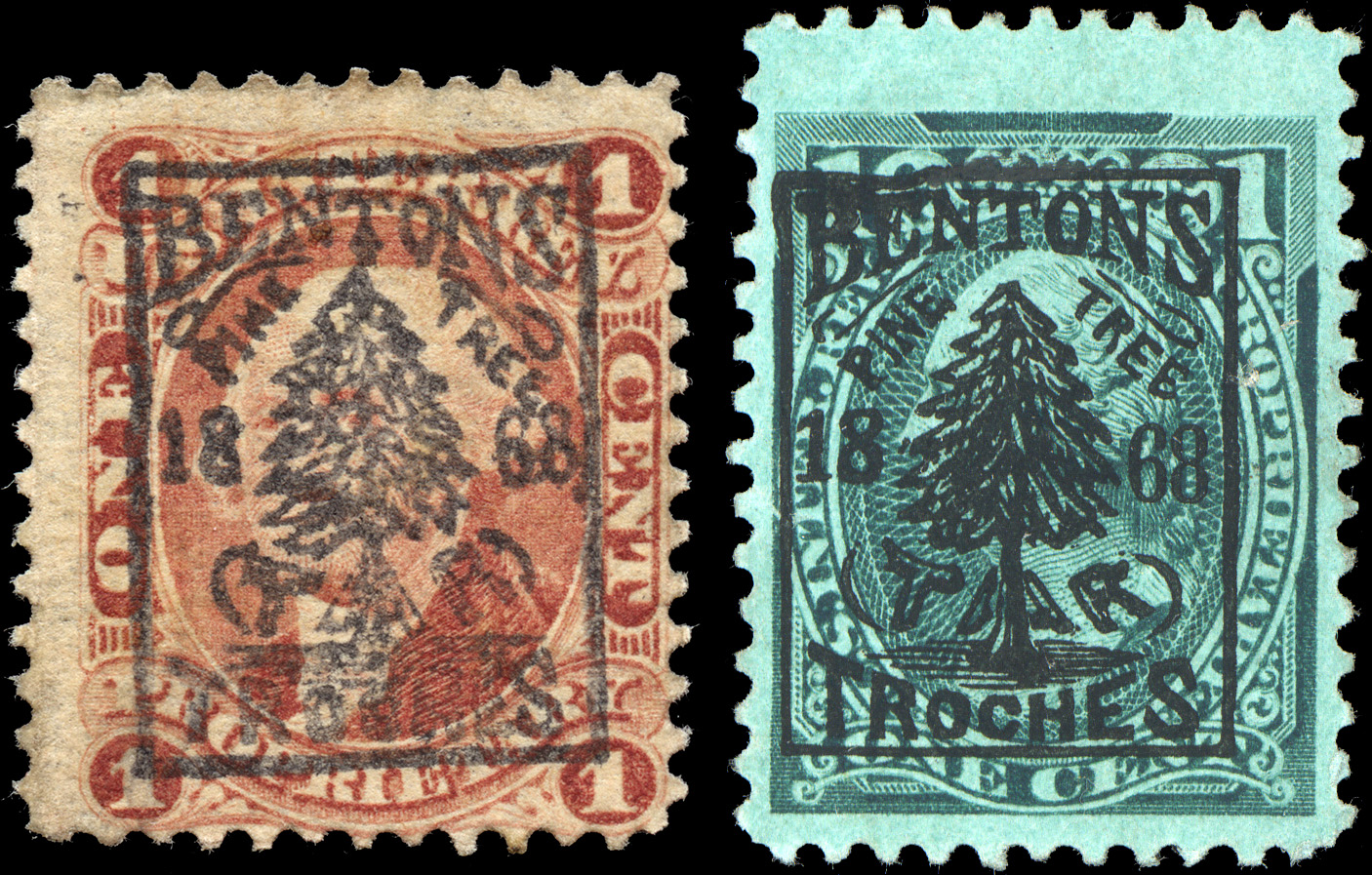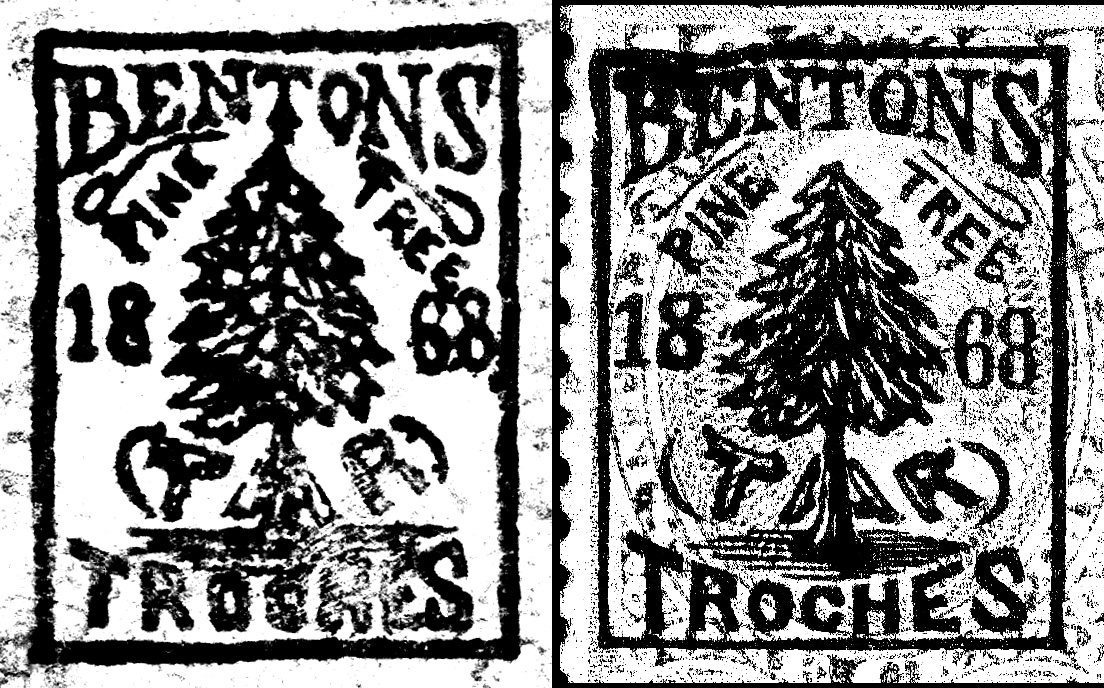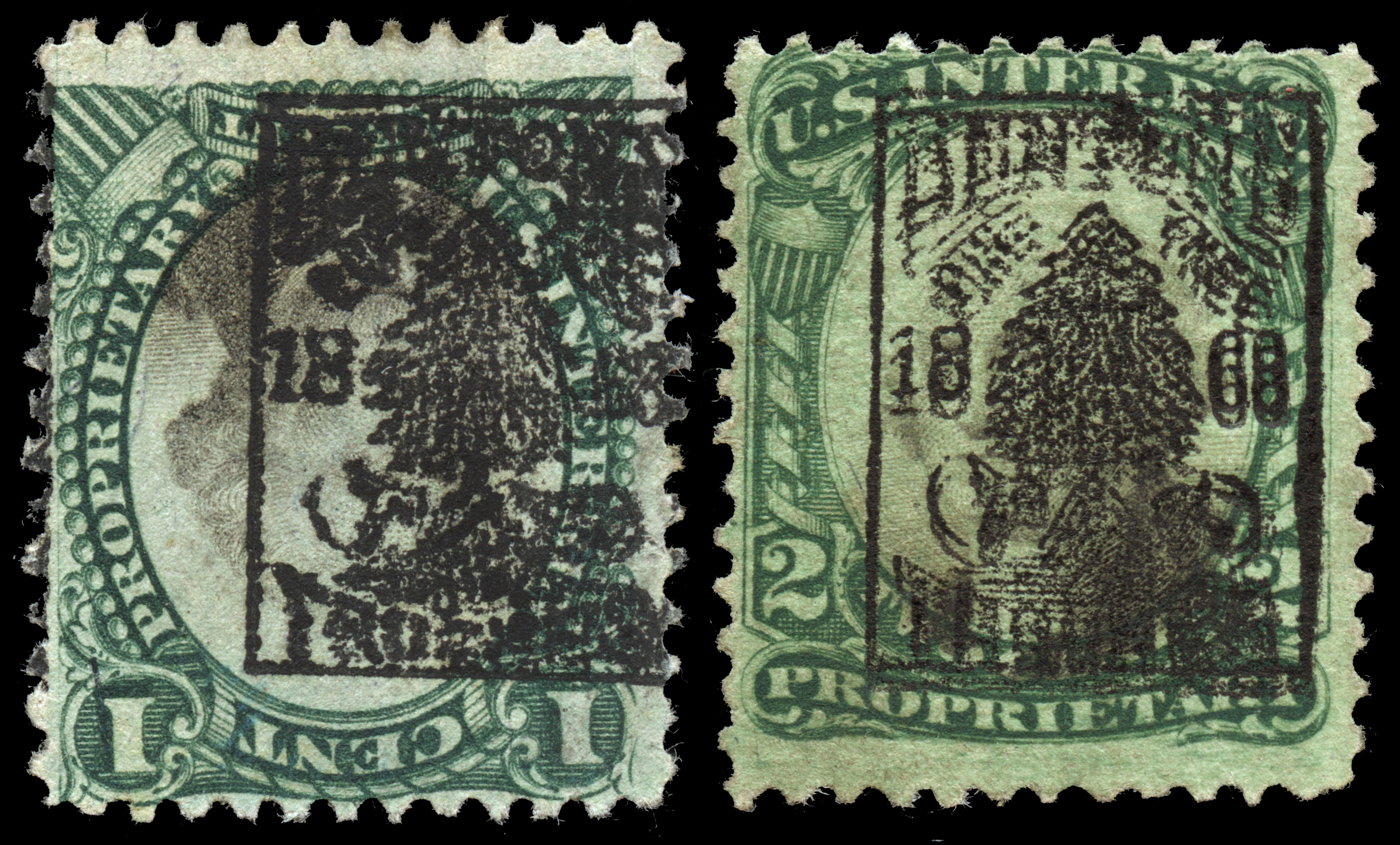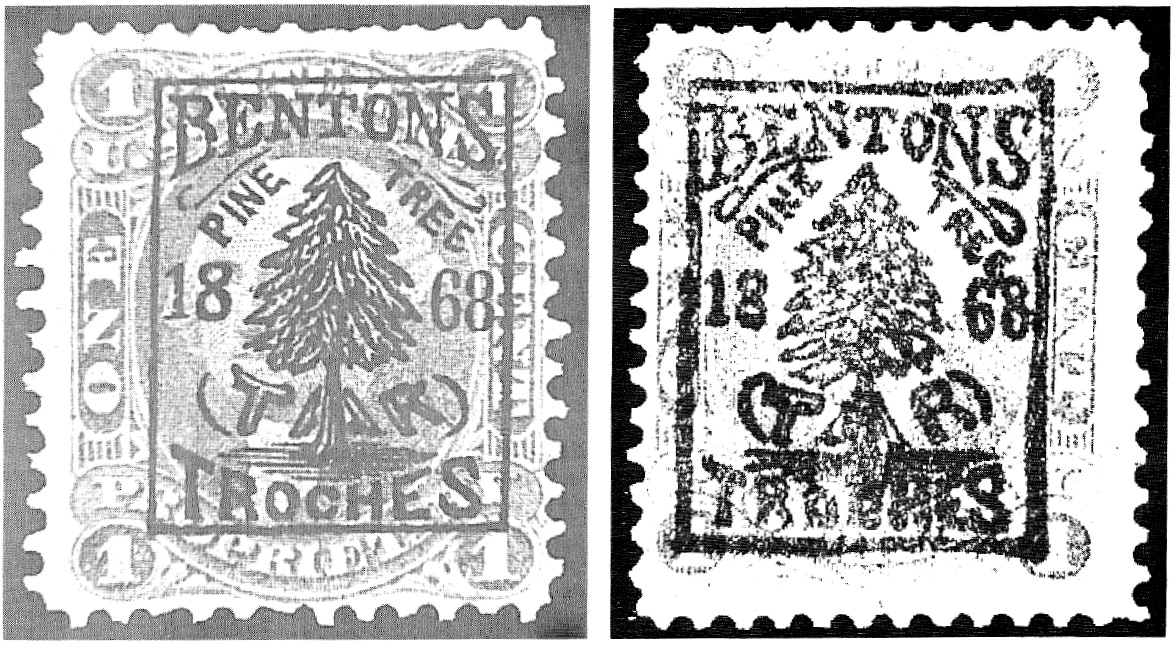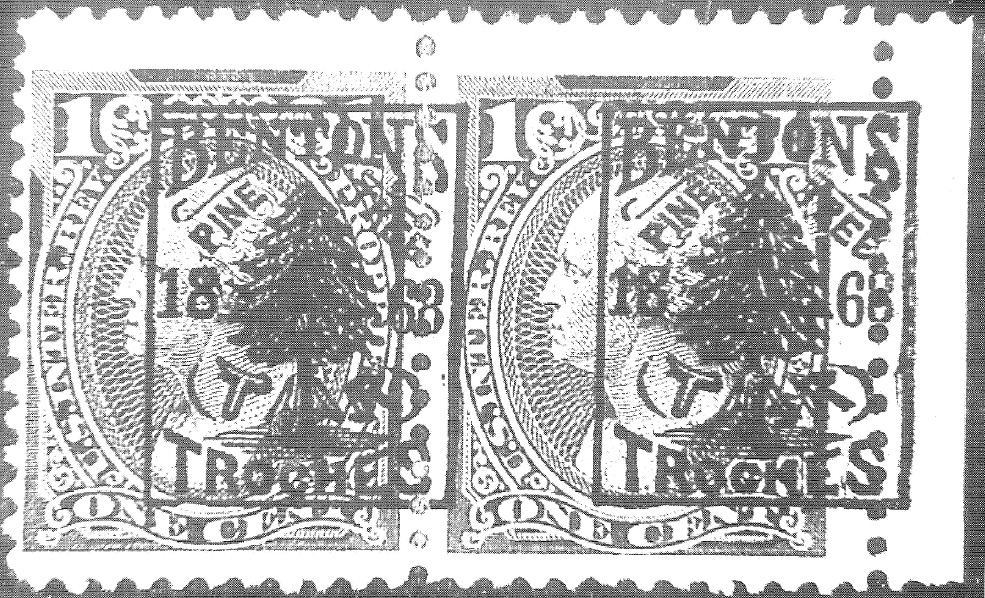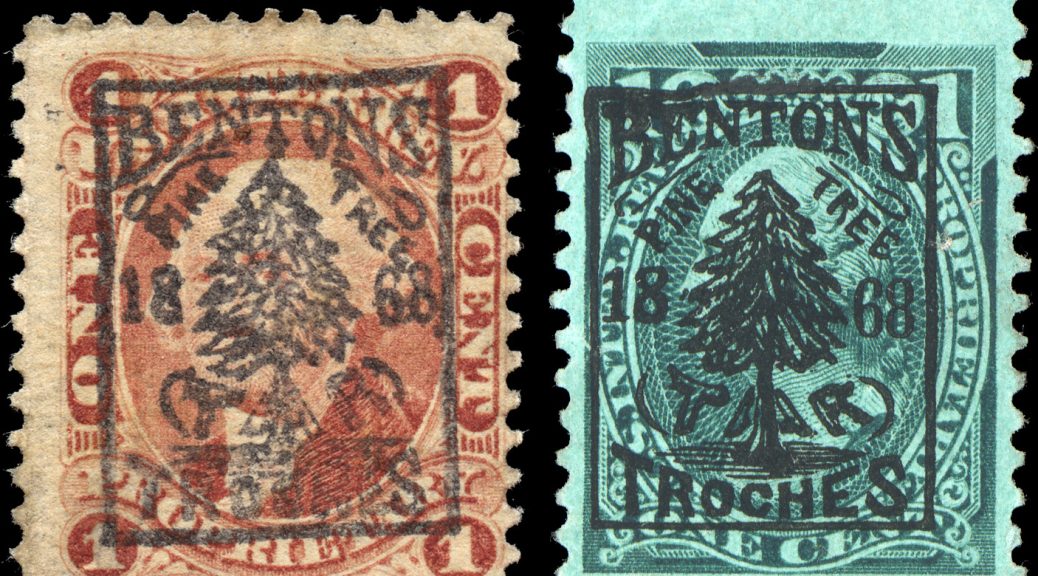
It’s Not Just The Imperfs And Part Perfs That Get Faked On US 1st Issue Revenues
Sometimes it’s the cancels.
The Benton’s Pine Tree Tar Troches cancel is, in my opinion, one of the two most famous pictoral cancels on U.S. 1st issue revenues, along with the Poland’s Magic Powders mortar & pestle cancel.
As I was perusing the recent proprietary cancel collection at INDYPEX, it contained numerous examples of the Benton cancel on various stamps, including one that was marked as a counterfeit cancel. I initially passed it over, as I did on my return trip the following weekend for a “second bite at the apple”, but the stamp kept nagging at my mind, as I knew I had seen an extensive writeup on it at some point in the past, but I couldn’t recall exactly where. It’s briefly mentioned in Mike Morrissey’s new catalogue, but I had seen a lengthier article *somewhere*. My folder of Mike’s cancel-specific articles didn’t contain it, so where was the blasted thing?
I emailed Mike, and as it turns out he had written an article on the counterfeit cancel for The American Revenuer in 1997… which predates my starting to collect U.S. revenues by almost 5 years, let alone when I joined the American Revenue Association, which explains why I couldn’t recall exactly where I had seen it.
So after reading the article, I decided to pick up the stamp as a reference piece. For those familiar with the cancel, it’s easy to tell that it’s a fake, but I can see where it would fool non-revenue-specialists.
The Images below show the counterfeit at left and a genuine strike at right, along with black & white images highlighting the two cancels a bit more clearly.
Next are two other examples of genuine cancels on 1st issue proprietaries.
The strikes found on the 2nd issue proprietaries tend to be MUCH more crisp and clearly defined than those found on 1st issue revenues or 1st issue proprietaries. On the earlier stamps the cancel can be quite blurred, multiple impressions, odd angles, etc., and IMO this is where there is the highest possibility of someone getting fooled.
If I had to hazard a guess, it appears to me that at some point late in the cancel’s lifetime, it was switched from a handstamp cancel (or some other manual method) to a letterpress printed cancel.
The easiest specific diagnostic beyond the overall courseness of the counterfeit cancel, in my opinion, is the spacing between the word TREE and 68 on the right side. On the counterfeit, the two elements collide, but on the genuine cancels, they are clearly separated.
Comparing my example with the one shown in Mike’s article, I believe it to be from the same source.
Mike’s original article from pages 12-13 of the January 1997 issue of The American Revenuer follows (the magazine issue is publicly available in its entirety at https://revenuer.org, so there are not any copyright issues with my reposting the article here).
The Benton Pine Tree Fakes, by Michael J. Morrissey, ARA
While at STaMpsHOW in St. Louis in August 1995, I visited the table of a dealer who customarily carried some revenue and other back-of-the-book material. He had several small stock books of early adhesive U.S. revenues. Among the material were two examples of the well-known Benton Pine Tree Tar Troches pictorial printed cancellation on the 1-cent First Issue Proprietary (Scott R3c). An excellent example of the cancel is shown in Figure 1. Troche, by the way, is an archaic term for a lozenge or cough drop. One was a fairly good strike on a clean undamaged stamp ( Figure 2 ) while the other was poorly centered and with an additional pen ruled horizontal line cancel in the style of a hand-made precancel.
An article in The American Philatelic Guide, Volume 1 Number 8, May 1880, E.E. Sterling indicated that the cancellation was made by a small electrotype plate. Electrotypy is a form of surface printing by the use of a letterpress and a plate made by electroplating the image to be printed onto the surface of the plate, which is usually made of lead or some other suitable metal. Whether this is in fact the case cannot now be said with absolute certainty, but it is undoubtedly printed from a surface printing style of Plate of an unknown number of subjects.
The cancel continued in use for many years as evidenced by Figure 3, a horizontal pair of the 1875 1-cent Proprietary on watermarked paper (ex-Joyce). These stamps were probably produced around 1878. As can be seen, the impressions are perfectly aligned, indicating a press-printed cancellation.
The stamps in the stock book struck me as rather odd looking. I have seen many of these over the years, yet these just did not fit the mold. First of all, the impression was rather ill-defined, yet the ink was not thick or heavily impressed. The normal pure black color was instead a thin blue-black. The cancel also seemed somewhat larger than usual. I concluded they were both fakes and from the same source.
The stamps bore rather hefty prices that were around market for the genuine article. I said nothing and walked away. I later saw Brian Bleckwenn of Christie’s on the floor. I have known Brian for over 25 years and believe him to be the First Issue expert. I mentioned the items to him and suggested he view them to see if he agreed. A short time later he came by and said he too considered them to be not genuine.
The story then picks up at the Garfield-Perry March Party in Cleveland in the cusp of Spring this year. The same dealer I saw in St. Louis was there. I once again reviewed his sales books and both of the fake cancels were still there. This time I spoke up as I believe this particular dealer to be completely honest. I advised him that in my opinion and that of Brian Bleckwenn that the cancels were fakes. We talked a while about St. Louis and my reasons for reaching such conclusion. I then suggested he consult with Eric Jackson, who is not only America’s premier revenue dealer, but an acknowledged fiscal philatelic expert who himself maintains a reference collection of fake revenue material.
The dealer seemed genuinely distressed, indicating that he purchased an old collection and that there had originally been five examples and that these two were all that remained. When Eric saw the stamps, he agreed that the cancels were bad, I bought one and I believe Eric acquired the other for his reference collection.
Let us now look at this cancellation both genuine and fake more closely. The measurements of the genuine are 14.25 X 18.5 mm and of the fake are 15 X 20 mm. Note also the irregularity of the alignment of the top of the letters in BENTON’S at the top of the cancel. In the genuine the tops of the letters are in an even horizontal line, while in the fake some letters are lower thus breaking up the alignment. Upon close examination other differences are also apparent.
How was the cancellation produced? I believe it was hand-drawn or traced on paper and then recreated in a rubber handstamp. When compared to the genuine it should fool no one. When seen without benefit of comparison to the original it is dangerous to all but the specialist. Caveat Emptor!
Figure 1. (Below Left) An excellent example of the genuine pre-cancellation. Ex-Joyce. (All photos by John Becker.)
Figure 2. (Below Right) The Benton fake. Note the many small differences between this and the genuine in figure 1 and 3.
Figure 3. The only recorded pair of stamps canceled with the Benton pine tree prove they were printed rather than handstamped cancels. Ex-Joyce.
